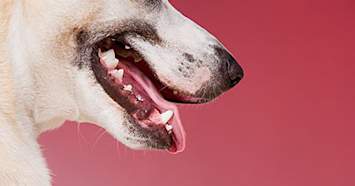
Epulis is a type of tumor that grows in the mouth, frequently on the gums near the teeth. If more than one epulis is found in the mouth, the plural name is “epulides.” These oral tumors actually grow from a ligament that holds a tooth to its bony socket, known as the periodontal ligament.
Although overall rare, epulides are actually the most common type of benign, or noncancerous, tumors that grow in a dog’s mouth. Two main types of epulides exist: peripheral odontogenic fibroma and acanthomatous ameloblastoma.
Peripheral odontogenic fibroma
This type of tumor may also be referred to as an ossifying epulis or a fibromatous epulis. Peripheral odontogenic fibromas are more common than acanthomatous ameloblastomas. These tumors grow outward from the gums, often attached by a stalk of gum tissue (i.e., a pendulous appearance). They are usually pink, smooth, and may be confused with gingival hyperplasia, a condition in which excess gum tissue is present around the base of the teeth.
Peripheral odontogenic fibromas are treated by removing the tumor, surrounding gum tissue, and often the tooth associated with it. If this tumor is left untreated, it will continue to grow slowly over time, invading nearby tissues and pushing teeth out of its way. This can cause pain and may make eating difficult.
Acanthomatous ameloblastoma
Acanthomatous epulis is another name for this type of epulis tumor. Compared to peripheral odontogenic fibromas, these epulides have more of a cauliflower, flattened shape and appearance. This type of epulis also tends to bleed more easily. Although technically benign, this tumor tends to be much more ‘aggressive’ than the other type of epulis. Instead of slowly growing and pushing structures out of the way, this tumor grows quickly and invades a larger area and proportion of the surrounding tissues.
Unfortunately, treatment for an acathomatous ameloblastoma requires not just removal of the tumor but often a significant portion of the upper or lower jaw bones. Radiation can also help with tumor control. Without treatment, this tumor grows quickly and overruns nearby structures, causing pain, inability to chew, and severe damage to a large area of surrounding tissues.
Diagnosis
Epulides look similar to each other and similar to other cancerous tumors that can be found in the mouth. Biopsy is the only way to confirm the tumor type. The biopsy will help your veterinarian to know how much surrounding tissue needs to be removed to prevent the tumor from coming back and/or invading other structures. If you have noticed a mass or tumor in your dog’s mouth, call your vet to get it checked out. Treatment and recovery is much easier while an epulis is still very small.